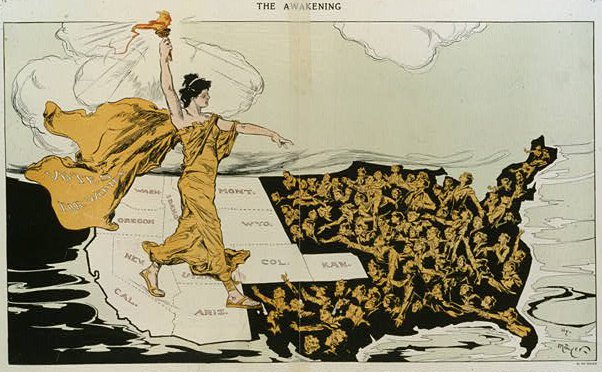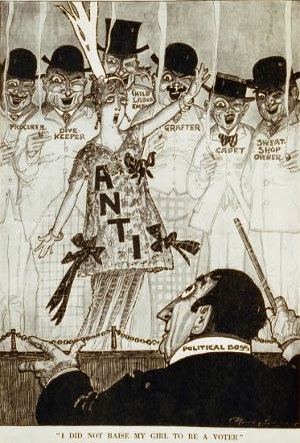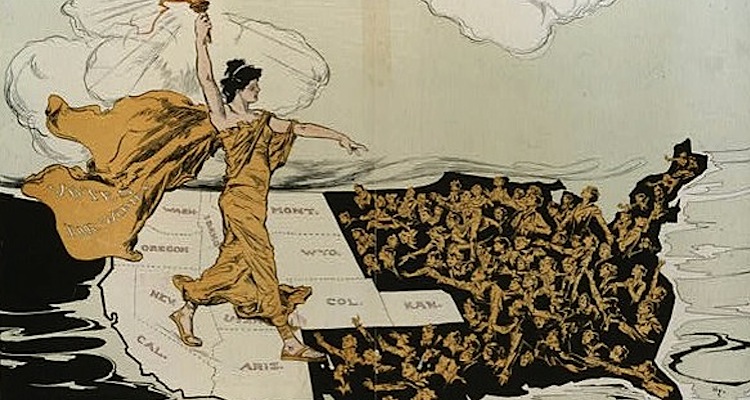Information and Articles About Women’s Rights in America, an important movement in women’s history
The women’s rights movement summary: Women’s rights is the fight for the idea that women should have equal rights with men. Over history, this has taken the form of gaining property rights, the women’s suffrage, or the right of women to vote, reproductive rights, and the right to work for for equal pay.
Women’s Rights Timeline: Here is a timeline of important events in the struggle for women’s liberation in the United States
Pre-settlement: Iroquois women have the power to nominate—and depose—council elders and chiefs.
1647: Margaret Brent demands two votes from the Maryland Assembly: one as a landowner and one as the legal representative of the colony’s proprietor, Lord Baltimore. She is refused.
1790: New Jersey gives the vote to “all free inhabitants” of the state. It is revoked from women in 1807.
1838: Kentucky allows widows to vote in local school elections, but only if they have no children enrolled.
1840: Lucretia Mott and Elizabeth Cady Stanton meet in London, where they are among the women delegates refused credentials to the World Anti-Slavery Convention. Women are very active abolitionists but are rarely in leadership positions.
1848: Mott and Stanton organize the Woman’s Rights Convention in Seneca Falls, N.Y., and take a cue from the Founding Fathers in issuing the Declaration of Sentiments: “We hold these truths to be self-evident: that all men and women are created equal.”
1868: The 14th Amendment guarantees civil rights to all citizens but gives the vote to men only.
1869: Wyoming Territory gives women the right to vote. The national suffrage movement splits into two factions: one that supports the 14th Amendment and the franchise for black men and one that calls for woman suffrage above all else.
1887: Federal legislation to end polygamy in Utah contains a measure to disenfranchise women, who had won the vote there in 1870. They wouldn’t get it back until 1895.
 1890: Congress threatens to withhold statehood from Wyoming because of woman suffrage. Wyoming threatens to remain a territory rather than give up women’s votes. Congress backs down, and Western states take the lead in giving women full voting rights.
1890: Congress threatens to withhold statehood from Wyoming because of woman suffrage. Wyoming threatens to remain a territory rather than give up women’s votes. Congress backs down, and Western states take the lead in giving women full voting rights.
 1912: With 4 million women eligible to vote in the West, presidential candidates vie for their attention for the first time. Democrat Woodrow Wilson wins.
1912: With 4 million women eligible to vote in the West, presidential candidates vie for their attention for the first time. Democrat Woodrow Wilson wins.
1913: Some 8,000 marchers turn out for the first national suffrage parade in Washington, D.C., the day before Wilson’s inauguration.
1915: Suffrage referendums are defeated in Massachusetts, New York, New Jersey and Pennsylvania.
1916: Jeannette Rankin of Montana is the first woman elected to the U.S. House of Representatives.
1917: Suffragists picket the newly reelected Wilson in front of the White House, the first time a public demonstration has targeted the presidential home. Throughout the summer, activists are arrested and imprisoned in the Occoquan Workhouse in Virginia where they were kept in isolation, beaten and force-fed.
1918: Wilson endorses the 19th Amendment to the Constitution mandating woman suffrage. It narrowly passes in the House, but fails by two votes in the Senate.
1919: On May 21, the Senate defeats the suffrage amendment for a second time by one vote. On June 4, the Senate passes the 19th Amendment by a two-vote margin and sends it to the states for ratification.
1920: On August 18, Tennessee is the 36th state to ratify the 19th Amendment, and “The right of citizens of the United States to vote shall not be denied or abridged by the United States or by any State on account of sex” becomes the law of the land.

